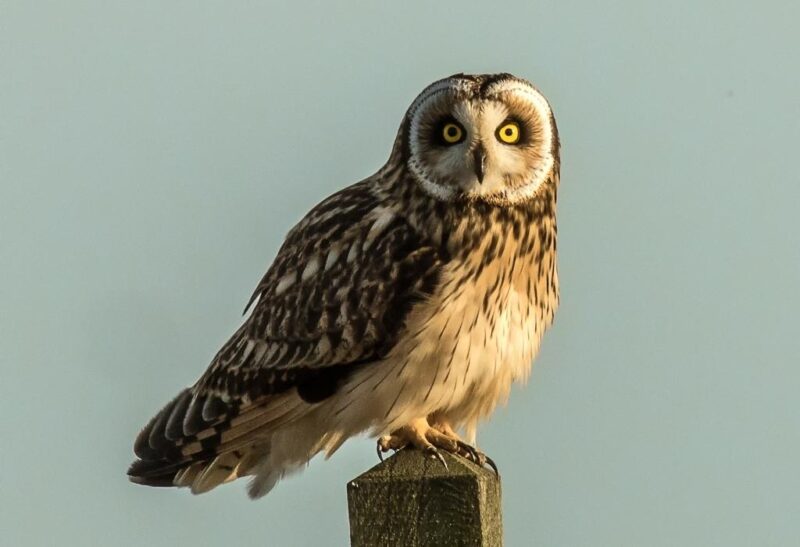Birds of prey also referred to as raptors, are predators that hunt other birds and animals for food and sustenance. These include a variety of eagles, falcons, hawks, owls, and vultures. They have specialized body parts that are biologically designed to make them powerful and efficient hunters.
The state is home to 8 hawk species, 2 eagle species, 3 falcon species, and 9 owl species. These include the Red-shouldered Hawks, Northern Harriers, Bald Eagle, Golden Eagle, Merlin, Peregrine Falcon, American Kestrel, Northern Saw-whet Owl, and Snowy Owl.
To know more about these raptors, their physical attributes, distinctive characteristics, habitat, place of origin, food preferences, and other interesting information, read further this article!
Table of Contents
The Hawk Species in Connecticut
Rough-legged Hawk

Named after their fully feathered legs to their toes, rough-legged hawks can consume a tenth of their body mass daily, which is roughly equal to 5 small mammals. They play an important ecological role in controlling pest populations, such as moles, mice, and rats, through predation.
- Scientific Name: Buteo lagopus
- Appearance: Relatively large hawk with long and broad wings, broad wingtips, a long tail, and a small bill
- Color: Light morphs have increased markings on the breast and belly, a dark tail band, and leg feathers that are heavily marked. Females have brown backs, while males have grayish backs. Dark morphs are dark brown to almost completely black in coloration and have either white bands (males) or a single black band (females) on their tails.
- Lifespan: Up to 18 years (wild), Up to 24 years (captivity)
- Habitat: Treeless tundra, alpine regions, low-lying boreal forests, agricultural lands, and open country areas, especially in early successional areas, shrublands, and grasslands.
- Length: 46 to 59 centimeters
- Weight: 745 grams to 1.38 kilograms
- Wingspan: 122 to 143 centimeters
- Diet: Primarily rodents such as voles and lemmings as well as small to medium-sized mammals such as hares, ground squirrels, and pocket gophers. They also consume birds such as ptarmigans. Occasionally, they feed on carrion or steal the prey of other hawks.
- Place Of Origin: North America, Canada, and Eurasia
- Characteristics: Solitary, but they migrate in small groups, territorial, and diurnal.
Northern Goshawk

Largest and bulkiest among all the accipiters, Northern goshawks notoriously hunt by stealth, which earned them the nicknames “gray ghost” and “phantom of the forest.” They’re rarely found in situations where they cannot defend themselves from their attackers. Due to this, they only have a few enemies in the wild.
- Scientific Name: Accipiter gentilis
- Appearance: Large and bulky bodies with broad and rounded wings, pointed wingtips, and long tails
- Color: Slate blue-gray to black plumage, dark heads with a white stripe located across the eye, pale gray underparts with a barred pattern, and light gray tails with dark bands.
- Lifespan: Up to 19.8 years (wild)
- Habitat: Deciduous and coniferous forests that are mature and consist of tall and old trees offering plenty of canopy coverage and areas that are open for foraging
- Length: 55 to 61 centimeters
- Weight: 631 grams to 1.37 kilograms
- Wingspan: 98 to 115 centimeters
- Diet: Their main mammal prey includes snowshoe hares, tree and ground squirrels, cottontails, and jackrabbits. They also consume birds such as ruffed grouse, hairy woodpeckers, and crows. Additionally, they consume reptiles, insects, and occasionally carrion.
- Place Of Origin: North America and Eurasia
- Characteristics: Diurnal, highly territorial, and solitary except during mating season. Most populations are sedentary. However, those breeding in the Northern and Northwestern regions of North America migrate.
Sharp-shinned Hawk
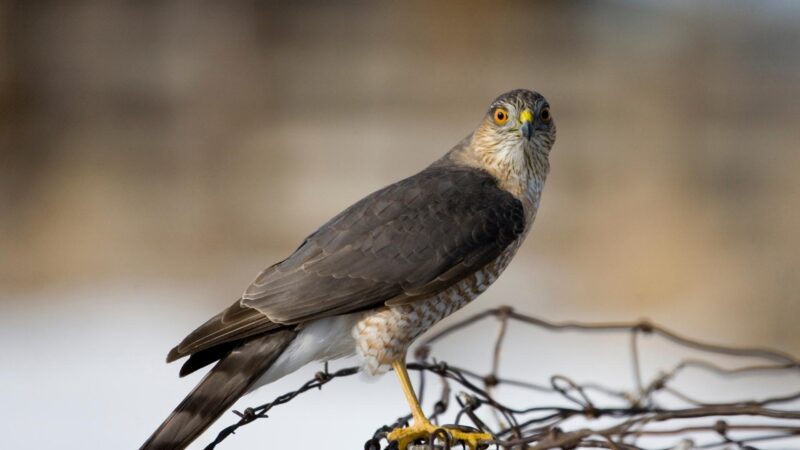
Considered the smallest North American accipiter, sharp-shinned hawks are bird-feeder raptors where they eat the small birds that feed on the seeds. They are agile and flexible fliers as they navigate through dense forests and woodlands at high speeds. When getting close to prey, they fly low near ground contours and pounce in at the last minute.
- Scientific Name: Accipiter striatus
- Appearance: Small hawks with small heads, long and square-tipped tails, hooked beaks, and short and rounded wings.
- Color: Bluish gray to slate plumage on the upperparts with a darker-colored crown. Their underparts are white in color and are barred with brown. The wings are dark above and light below. Females have browner upperparts.
- Lifespan: Up to 19.9 years (wild)
- Habitat: Forest and forest edges that are dense and preferably with a closed canopy. Specifically, they favor conifer, oak-hickory, and hardwood forests.
- Length: 24 to 34 centimeters
- Weight: 87 to 218 grams
- Wingspan: 53 to 65 centimeters
- Diet: Small birds such as sparrows, warblers, and thrushes make up about 90 percent of the raptor’s diet. They also consume large birds such as doves, quail, and woodpeckers, as well as small rodents such as voles and mice. Occasionally, they consume grasshoppers and moths.
- Place Of Origin: North America, Venezuela, Northern Argentina
- Characteristics: Territorial, especially during the breeding season. They are diurnal and mainly solitary but can be found migrating in small groups.
Cooper’s Hawk

Cooper’s hawks are notoriously known for squeezing their prey to death using their feet or drowning them underwater. They fly by executing rapid wing beats, which makes them proficient in navigating through densely vegetated habitats. Additionally, they can also chase prey on the ground through thickets when necessary.
- Scientific Name: Accipiter cooperii
- Appearance: Medium-sized hawks with long and lean bodies, large heads, broad shoulders, broad and rounded wings, and long and rounded tails.
- Color: Steel bluish-gray above with reddish to brownish barred underparts, dark bands on the tail, dark crowns, lighter-colored napes, and hooked bills.
- Lifespan: Up to 20 years (wild)
- Habitat: Open woodland habitats, mixed and deciduous forests, and leafy suburbs
- Length: 35 to 50 centimeters
- Weight: 280 to 566 grams
- Wingspan: 75 to 94 centimeters
- Diet: Primarily birds such as mourning doves, American robins, rock pigeons, and poultry. They also consume chipmunks, bats, hares, squirrels, and mice.
- Place Of Origin: North America
- Characteristics: Diurnal, migratory, solitary except during the breeding season, and territorial
Red-Shouldered Hawk
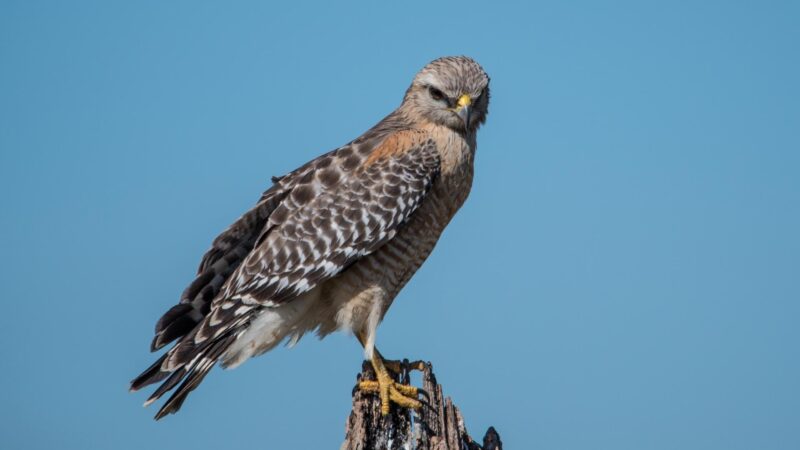
This forest-dwelling raptor is considered one of the most vocal American hawks as it is often spotted soaring through the skies and calling with loud and distinctive screaming sounds. When hunting, red-shouldered hawks use the element of surprise to capture their prey through a perch-and-wait approach.
- Scientific Name: Buteo lineatus
- Appearance: Medium-sized, heavy-bodied hawks with broad and rounded wings and medium-length tails
- Color: Brown head and back, reddish underparts that are streaked or barred with dark brown, dark brown or black tails with white bands, and pale crescents near the wingtips that are visible during flight.
- Lifespan: Up to 20 years (wild)
- Habitat: Upland mixed deciduous-conifer forests, bottomland hardwood stands, and flooded deciduous swamps. They prefer having dead trees in their vicinity so they could perch freely.
- Length: 43 to 61 centimeters
- Weight: 550 to 700 grams
- Wingspan: 92 to 107 centimeters
- Diet: Small mammals such as squirrels and rabbits, snakes, lizards, toads and frogs, large insects, and crayfish. They occasionally feed on birds such as doves, sparrows, and starlings.
- Place Of Origin: Eastern North America and Southern Canada
- Characteristics: Diurnal and territorial. Most populations are sedentary, but those found in the northern regions of their range migrate. They are solitary, even when migrating.
Northern Harrier
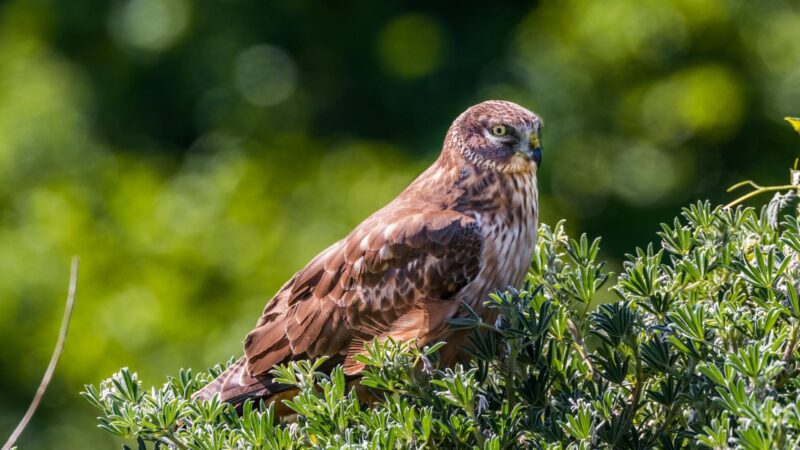
Compared to other species of hawks, Northern harriers depend heavily on their sense of hearing to locate and capture prey. Other than their agile and acrobatic flying abilities, they also like to walk and hope to retrieve prey, collect materials for their nests, and retrieve strayed nestlings.
- Scientific Name: Circus cyaneus
- Appearance: Medium-sized, slender-bodied raptors with flat faces, long and broad wings, long and rounded tails, and hooked bills. They have distinctive feathers around their face that form a disk, much like an owl’s.
- Color: Males have gray upperparts and white underparts, with chests that are spotted and black-tipped wings. Females, on the other hand, have brown plumages except for their underwings, which are striped with white. Both sexes have yellow eyes and a white rump patch seen in flight.
- Lifespan: Up to 16 years (wild)
- Habitat: Mainly in open habitats such as grasslands, wetlands, fields, upland prairies, meadows, and desert steppe, but they can also be found in riparian zones and agricultural areas.
- Length: 41 to 50 centimeters
- Weight: 290 to 750 grams
- Wingspan: 97 to 122 centimeters
- Diet: Deer mice, meadow voles, rabbits, shrews, songbirds (such as song sparrows, meadowlarks, and northern cardinals), rats, and other small mammals. They also feed on reptiles, birds, and amphibians.
- Place Of Origin: North America
- Characteristics: May be solitary or form loose groups with other individuals when nesting or roosting. They are less territorial during the breeding season, except when they defend their nest sites against intruders. Additionally, they are migratory and diurnal.
Broad-winged Hawk

Broad-winged hawks are known to migrate together in huge flocks that can consist of up to thousands of birds and are referred to as “kettles,” which become prime attractions at hawkwatch sites during the fall season. They become elusive during nesting season as they move further into forest interiors.
- Scientific Name: Buteo platypterus
- Appearance: Small, compact-bodied hawks with large heads, broad wings, and short and square-tipped tails.
- Color: Reddish brown heads, pale undersides with chestnut or cinnamon-colored barred patterns, dark brown backs, and black and white bands on the tail. There also exists a rare dark morph that is entirely dark brown in plumage.
- Lifespan: Up to 18.3 years (wild)
- Habitat: Mixed or deciduous forests that are preferably far from human disturbance. They opt for having water and open areas nearby.
- Length: 34 to 44 centimeters
- Weight: 265 to 560 grams
- Wingspan: 81 to 100 centimeters
- Diet: Mostly small rodents, toads, and frogs, but they also feed on invertebrates (such as junebugs, grasshoppers, and ground beetles), reptiles, mammals, and birds (particularly juveniles and nestlings).
- Place Of Origin: Eastern United States and Southern Canada
- Characteristics: Diurnal, solitary except when migrating, territorial, and migratory.
Red-tailed Hawk
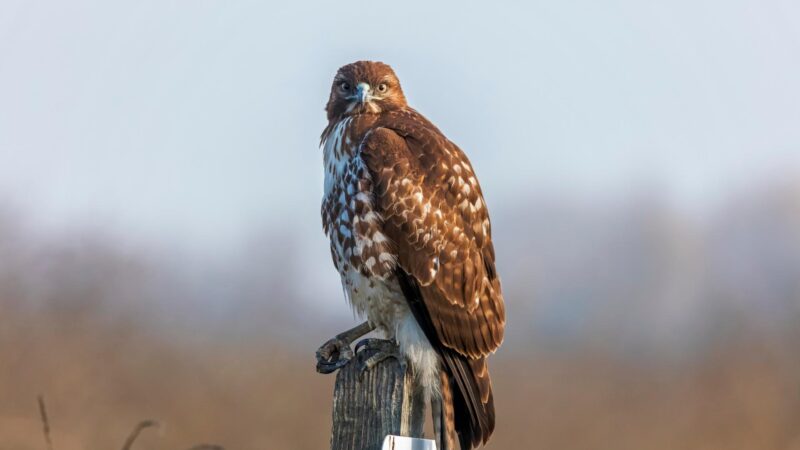
As one of the most commonly observed hawks in North America, red-tailed Hawks are frequently seen perching in trees along roadsides and nesting within the woodlands of residential neighborhoods. They can locate a mouse even at a height of 100 feet. Filmmakers use the cries of these hawks to represent hawk or eagle sounds in movies and TV shows.
- Scientific Name: Buteo jamaicensis
- Appearance: Large hawks with broad and rounded wings and short but wide tails
- Color: Plumage ranges from a light auburn color to deep brown. They have pale underparts, streaked bellies, and dark-barred between the wrist and shoulder. Their tails are usually a gradient of brownish-red above and a paler shade below. Dark-morphed birds have an overall chocolate brown plumage with a warm red tail.
- Lifespan: Up to 21.5 years (wild), Up to 29.5 years (captivity)
- Habitat: Virtually all types of open habitats, including fields and pastures, scrublands, deserts, roadsides, grasslands, broken woodlands, parks, and tropical rainforests.
- Length: 45 to 65 centimeters
- Weight: 795 grams to 1.46 kilograms
- Wingspan: 114 to 133 centimeters
- Diet: Small mammals such as jackrabbits, mice, voles, rabbits, woodrats, snowshoe hares, and ground squirrels make up the bulk of their diet. They also consume birds such as blackbirds, pheasants, starlings, and bobwhites, as well as carrion and snakes.
- Place Of Origin: Northern America and Canada
- Characteristics: Diurnal, highly territorial, solitary except during breeding season, and partially migratory, as some populations are sedentary
The Eagle Species in Connecticut
Bald Eagle
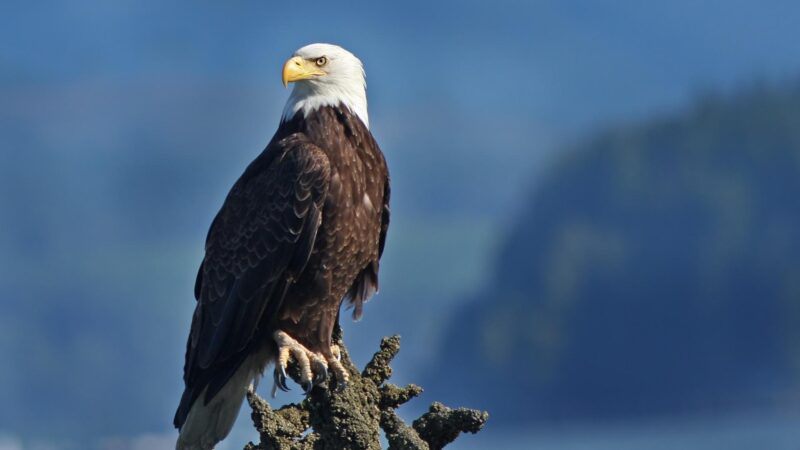
Considered the national bird of the United States, bald eagles have historically been pushed to the brink of extinction due to the overuse of pesticides. Now, the regal-looking raptor is widely distributed in North America and can be seen soaring solitarily in the skies, chasing other birds to steal food from, or gathered in groups of hundred individuals during the winter season.
- Scientific Name: Haliaeetus leucocephalus
- Appearance: Heavy-bodied raptors with large heads and broad wings that are flattened during flight.
- Color: Bald eagles reach their mature coloration in their 5th year of age, wherein they have distinctive yellow eyes and beaks, dark brown plumage, and white heads and tails.
- Lifespan: 15 to 20 years (wild), 20 to 30 years (captivity)
- Habitat: Forested areas that are near large bodies of water, such as coastal estuaries, sea coasts, and inland rivers and lakes. They can also be seen in open uplands during the winter season.
- Length: 79 to 94 centimeters
- Weight: 3 to 6.3 kilograms
- Wingspan: 178 to 204 centimeters
- Diet: Primarily fish such as catfish, salmon, shad, and herring, but they eat whatever’s available and can also consume reptiles, birds, amphibians, small mammals (muskrats and rabbits), and invertebrates. They eat their prey fresh, live, or as carrion.
- Place Of Origin: North America
- Characteristics: Often solitary except during nesting season, but they can also be seen roosting communally in groups consisting of up to 400 individuals. They are diurnal, migratory, and territorial.
Golden Eagle

Known for being the largest raptor in North America, golden eagles are known to be speedy fliers that exhibit great maneuverability despite their size. They can perform a series of steep dives and upward swoops in a courtship display referred to as sky-dancing. These predatory birds are known to engage in playing while in mid-air.
- Scientific Name: Aquila chrysaetos
- Appearance: Very large birds with long and broad wings, relatively small heads, long tails, and feathered legs down to their toes
- Color: Dark brown plumage with a golden area near their head crown, sides of the neck and face, and nape. Their flight feathers are brownish gray, while the feathers on their head, body, and smaller feathers are blackish in plumage. They have grayish-brown tails, dark brown eyes, black claws and beaks, and yellow feet.
- Lifespan: Up to 32 years (wild), Up to 46 years (captivity)
- Habitat: Open and semi-open country areas with vegetation, such as canyonlands, riverside cliffs, rimrock terrains, and bluffs, as well as grasslands, shrublands, and forests
- Length: 70 to 84 centimeters
- Weight: 3 to 6.125 kilograms
- Wingspan: 185 to 220 centimeters
- Diet: Small to medium-sized mammals such as ground squirrels, rabbits, prairie dogs, hares, black-tailed jackrabbits, and marmots. They can also feed on birds such as deer, cranes, swans, and domestic livestock, as well as mammals such as bighorn sheep, mountain goats, and bobcats. Additionally, they also consume carrion.
- Place Of Origin: North America and Mexico
- Characteristics: Some golden eagle populations are migratory, while others are sedentary. They are diurnal, and territorial and are usually solitary or in pairs. However, juveniles that have not been mated, as well as adults that are wintering can be found in groups.
The Falcon Species in Connecticut
Merlin

Relying on agility and speed to hunt for prey, merlins are small but fierce raptors that can perform surprise attacks on small shorebirds and songbirds. They are also referred to as pigeon hawks as they resemble pigeons during flight. In recent years, their populations have increased in cities and towns as they breed on conifers.
- Scientific Name: Falco columbarius
- Appearance: Small, stocky-bodied falcons with a blocky head, powerful build, stocky chest, sharply-pointed wings, and a medium-length tail.
- Color: Upperparts are purplish, slaty blue, or dark brown in color that is streaked with black starting from the crown down to the shoulders and back. Underparts are cream-colored to rich buff that is heavily streaked with dark brown or black, except for their throat, which is white in color. Their tails are white-tipped and are either banded with black or have dark brown bars.
- Lifespan: Up to 11 years (wild), Up to 15 years (captivity)
- Habitat: Open and semi-open areas such as in fragmented woodlots, near forested openings, coastal areas, riversides, grasslands, small groves of deciduous trees, and even in conifers planted in schoolyards and residential areas
- Length: 24 to 33 centimeters
- Weight: 160 to 240 grams
- Wingspan: 53 to 68 centimeters
- Diet: Primarily birds such as house sparrows, dunlins, horned larks, and other shorebirds. They also eat large insects such as nestling birds, dragonflies, and small mammals.
- Place Of Origin: North America and Eurasia
- Characteristics: Social except during mating season, migratory, territorial, and diurnal.
Peregrine Falcon

Peregrine falcons are named after their wide occurrence worldwide as “peregrine” means wanderer. They have been documented to eat as many as 2,000 bird species. As strong fliers, they are often considered the fastest birds in the world that are capable of traveling at 24 to 33 miles per hour (mph) when cruising and up to 67 mph when chasing prey.
- Scientific Name: Falco peregrinus
- Appearance: Large falcons with long tapered wings and narrow, short tails.
- Color: Their color and sizes vary according to subspecies. Generally, they have white faces with black-striped cheeks, slate and blue-gray wings, pale underbellies, and backs that are barred with black.
- Lifespan: Up to 20 years (wild), Up to 25 years (captivity)
- Habitat: Open landscapes such as cliffs or skyscrapers, at elevations of up to 12,000 feet, alongside rivers and coastlines, mudflats, lake edges, mountain chains, and even in cities.
- Length: 36 to 49 centimeters
- Weight: 530 grams to 1.6 kilograms
- Wingspan: 100 to 110 centimeters
- Diet: Mostly birds such as sandhill cranes, hummingbirds, white-throated swifts, shorebirds, ptarmigans, pigeons, longspurs, and starlings. They also eat a considerable number of bats and occasionally feed on rodents and fish that they steal from other raptors.
- Place Of Origin: Western Eurasia and Africa
- Characteristics: Diurnal, primarily solitary except during the breeding season, territorial, and migratory
American Kestrel
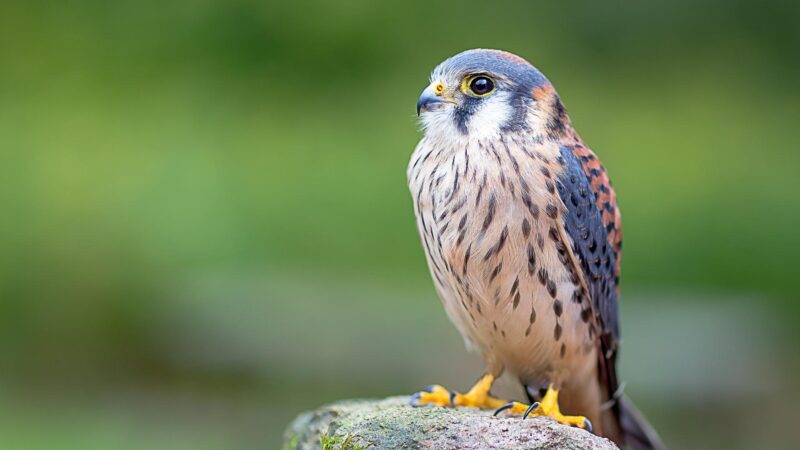
Considered the smallest and most widespread falcon in North America, they are known for their unique flight pattern that is characterized by short glides and rapid wing beats. They’re also referred to as sparrow hawks and are often seen perching on roadside power lines and telephone poles.
- Scientific Name: Falco sparverius
- Appearance: Small falcons with small heads, narrow wings, sharp beaks, and long, square-tipped tails.
- Color: Rusty brown and black-spotted upperparts and pale underparts, with a black band, found near the tail tip. Males have blue-gray crowns and wings, while females are reddish-brown. Both sexes display a black and white facial pattern, with two prominent and distinctive black slashes on their faces which resemble sideburns or a mustache.
- Lifespan: Up to 11 years (wild), Up to 17 years (captivity)
- Habitat: Open areas that have sparse trees and short ground vegetation, such as those found in parks, meadows, deserts, farm fields, grasslands, and even in the suburbs and cities.
- Length: 22 to 31 centimeters
- Weight: 80 to 165 grams
- Wingspan: 51 to 61 centimeters
- Diet: Mostly insects, other invertebrates, birds, and small rodents. Common prey includes cicadas, grasshoppers, spiders, scorpions, voles, bats, mice, and small songbirds. They occasionally feed on lizards, small snakes, and frogs.
- Place Of Origin: Central and South America
- Characteristics: Solitary except during mating season, diurnal, migratory, and territorial especially when it comes to prey and their nesting sites
The Owl Species in Connecticut
Great Gray Owl
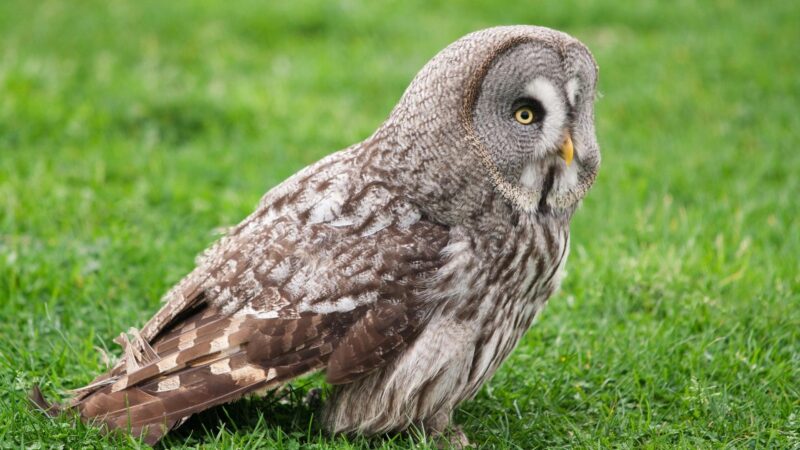
The great gray owl is one of the tallest owls in North America and is known for being highly reclusive, which earned it the nickname “Phantom of the North” or “Great Gray Ghost.” Its distinctive facial disk feathers help in directing sounds toward its ear openings, making them efficient at detecting the quiet sounds of its rodent prey.
- Scientific Name: Strix nebulosa
- Appearance: A large and tall owl with a big head, large facial disks, broad wings, no ear tufts, and long tails
- Color: Predominantly gray coloration with varying shades of white, gray, and brown on its ventral side, distinctive facial disks as they have two noticeable gray concentric circles, a black spot on the chin right above two white mustaches, and an obvious white collar on the neck.
- Lifespan: Up to 18 years (wild)
- Habitat: Evergreen, mixed deciduous, fir, or pine forests with open areas and scattered trees, as well as oak woodlands that border open fields.
- Length: 61 to 84 centimeters
- Weight: 790 grams to 1.45 kilograms
- Wingspan: 137 to 153 centimeters
- Diet: Small mammals, such as pocket gophers, voles, lemmings, moles, chipmunks, and mice.
- Place Of Origin: North America
- Characteristics: Nocturnal, non-territorial, sedentary, but they tend to travel outside their home range to forage for food and solitary except during breeding season.
Short-eared Owl
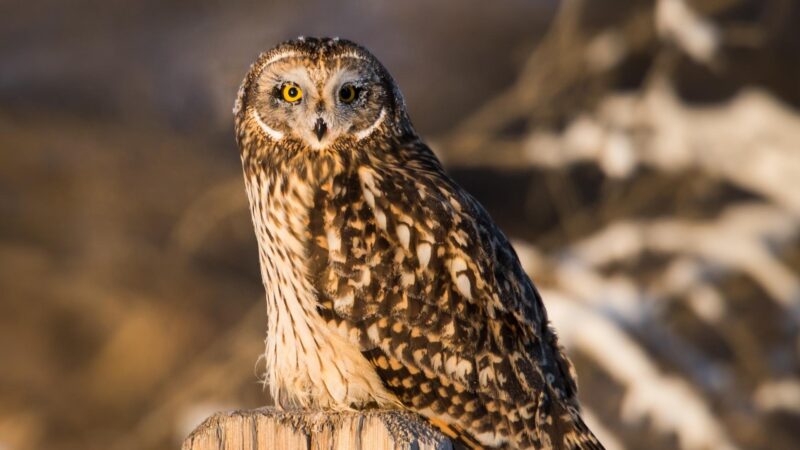
Notorious for decapitating and disemboweling small mammals before ingesting them whole, short-eared owls display excellent maneuverability during flight as they can drop suddenly to pursue prey or fly into the air to avoid predators. This raptor is one of the world’s most widely distributed owls. Compared to other owls, they are often seen during the day.
- Scientific Name: Asio flammeus
- Appearance: Medium-sized owls that have rounded heads, broad wings with smoothly-rounded tips, short tails, and ears that are difficult to see as they are extremely short.
- Color: These owls vary in color, but they are generally spotted with medium brown and have white and buff upperparts. Their faces are pale with yellow eyes and outlined with black, while their breasts are brown-streaked. Parts of their head, legs, and flanks are white.
- Lifespan: Up to 21.8 years (wild)
- Habitat: Large, open areas that are characterized by having low vegetation, such as coastal grasslands, shrubsteppe, prairies, meadows, dunes, and agricultural areas.
- Length: 34 to 42.3 centimeters
- Weight: 206 to 475 grams
- Wingspan: 9.5 to 11 centimeters
- Diet: Primarily small mammals such as voles, mice, lemmings, pocket gophers, weasels, shrews, bats, and muskrats. They also consume birds such as storm petrels, shorebirds, rails, and songbirds.
- Place Of Origin: Eurasia, North and South America, Hawaii, the Caribbean, and the Galapagos Islands
- Characteristics: Nocturnal, relatively social as they roost communally, but they always hunt solitarily, territorial, and migratory
Northern Saw-whet Owl
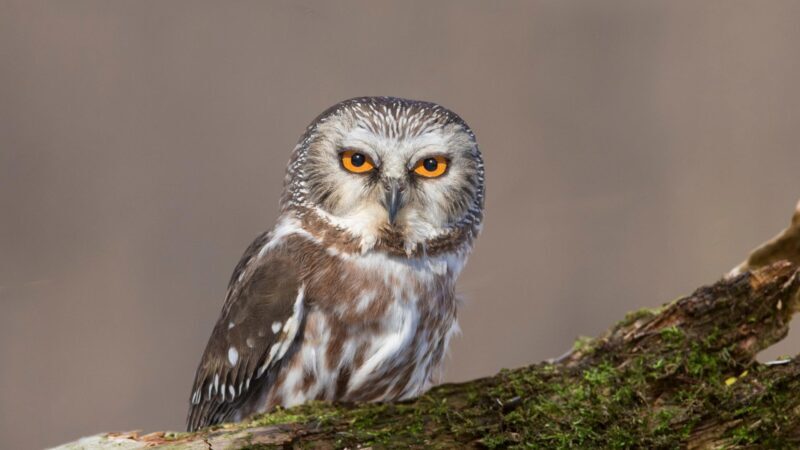
Northern saw-whet owls are the smallest birds of prey found in North America. They have a highly developed sense of hearing as they can locate prey just by sound. When faced against predators while roosting in dense conifers, their first line of defense is sitting still and not flying, which made birdwatchers assume they are relatively tame owls.
- Scientific Name: Aegolius acadicus
- Color: Mottled brown or reddish-brown plumage with a white spots on the head, white facial disks, white-streaked abdomen, dark-colored beaks, yellow eyes, and barred tails
- Appearance: Small owls with large and rounded heads, no ear tufts, heavily feathered feet and legs, and large facial disks
- Lifespan: Up to 7 years (wild), Up to 16 years (captivity)
- Habitat: Forests with deciduous trees for nesting, open understories for foraging, and dense conifers for roosting, but they also live in a wide range of wooded habitats, savannahs, and shrub-steppes.
- Length: 18 to 21.5 centimeters
- Weight: 65 to 110 grams
- Wingspan: 45 to 60 centimeters
- Diet: Primarily small mammals such as white-footed mice, montane voles, bats, shrews, and the juveniles of squirrels, pocket gophers, and chipmunks. When migrating, they consume birds such as sparrows, chickadees, and warblers.
- Place Of Origin: North America
- Characteristics: Nocturnal and migratory, but some populations are sedentary, solitary, and territorial.
Barn Owl

Barn owls have striking appearances due to their ghostly pale coloration. Birdwatchers and enthusiasts can locate them by listening for their eerie calls, which sound different compared to the hoots of other owls. They often inhabit barns and other abandoned buildings, which earned them their name.
- Scientific Name: Tyto alba
- Appearance: Medium-sized owls with heart-shaped faces, long and rounded wings, short tails, long legs, and no ear tufts.
- Color: Pale overall plumage, light brown head and back that are spotted black and white, grayish-white undersides, and white or light brown downy tail feathers.
- Lifespan: Up to 34 years (wild)
- Habitat: Open habitats such as marshes, grasslands, ranchlands, agricultural fields, deserts, forest strips, cities, and suburbs.
- Length: 32 to 40 centimeters
- Weight: 430 to 620 grams
- Wingspan: 107 to 110 centimeters
- Diet: Mostly small mammals, especially lemmings, rats, voles, mice, rabbits, shrews, and bats. They occasionally feed on birds such as meadowlarks, starlings, and blackbirds.
- Place Of Origin: America and Eurasia
- Characteristics: Either solitary or found in pairs, nocturnal, most populations are migratory, but some are sedentary and non-territorial.
Eastern Screech Owl

Eastern screech owls are common residents of open clearings and woodlands, so much so that they became excellent at camouflaging among tree crannies and nooks thanks to their distinctive plumage that’s unlike any other North American owl. They are notorious predators of European starlings. However, these birds usually kick out the owls from their nesting sites.
- Scientific Name: Megascops asio
- Appearance: Small, stocky-bodied bird with a large head, rounded wings, short and square tail, large feet with feathered toes, large pointed ear tufts, and extremely short neck.
- Color: They come in two color morphs that have either a grayish or rufous overall plumage. Both morphs have bold streakings and spots on their breasts and yellow eyes and beaks.
- Lifespan: Up to 14.5 years (wild)
- Habitat: Found in almost any habitat with nest boxes or tree cavities, as well as open understories. They can also live in suburban landscapes, farmlands, city parks, and woodlands found along rivers and streams.
- Length: 16 to 25 centimeters
- Weight: 121 to 244 grams
- Wingspan: 48 to 61 centimeters
- Diet: Small mammals such as squirrels, rabbits, mice, rats, and moles, as well as small birds such as European starlings, waxwings, flycatchers, finches, and swallows. They occasionally feed bats.
- Place Of Origin: Eastern North America, Canada, and Mexico
- Characteristics: Sedentary, solitary except during the mating and winter season, nocturnal, and territorial
Barred Owl

Barred owls are known for their recognizable 9-syllable hooting call “Who cooks for you? Who cooks for you all?” Birdwatchers and enthusiasts can locate them in forests near bodies of water by imitating their calls and see if any owl would fly in and investigate. These raptors are also capable of flying noiselessly through forest snoozes and dense canopies.
- Scientific Name: Strix varia
- Appearance: Large, stocky-bodied owls with rounded heads and tails, and no ear tufts
- Color: Gray-brown overall plumage with edges that are buff-white in color, brown bars that are vertical on their underparts and horizontal on their upper breast, and barred white and brown tail and wings. They have brown eyes and a grayish-white facial disc.
- Lifespan: Up to 18 years (wild)
- Habitat: Coniferous or mixed forests that are often near water sources and have large trees, dense foliage, and cavities, such as those found in uplands, streamsides, and swamps
- Length: 48 to 51 centimeters
- Weight: 630 to 800 grams
- Wingspan: 107 to 111 centimeters
- Diet: Small animals such as chipmunks, rabbits, squirrels, voles, and mice, as well as amphibians, birds, invertebrates, fish, crayfish, and reptiles.
- Place Of Origin: Eastern North America
- Characteristics: Primarily nocturnal owls, however, they have been reported to be active during the day. They’re solitary, but they live in groups during the breeding season. Additionally, they’re territorial and sedentary.
Long-eared Owl
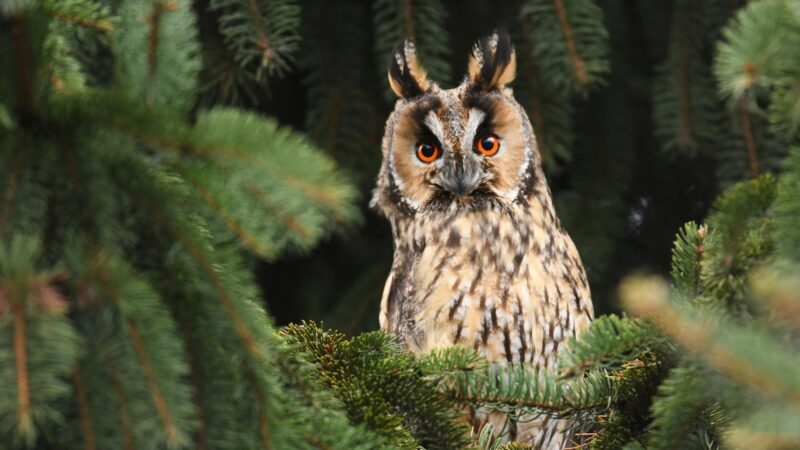
Long-eared owls are lanky-bodied raptors that seem to wear a permanently surprised expression due to their long ear tufts. They’re excellent nocturnal hunters that are capable of camouflaging themselves against both prey and predators. Despite their elusive nature, they are relatively easy to find as they roost in groups during the winter season.
- Scientific Name: Asio otus
- Appearance: Medium to long-sized, slender-bodied owls with large and squarish heads, long ear tufts, long and narrow facial disks, rounded wings, fully-feathered legs and toes, and long tails.
- Color: Brownish gray plumage with vertical streaks, pale face patches that are shaped like eyebrows, and a singular white patch below their black beaks. They also have yellow or orange eyes.
- Lifespan: Up to 27.8 years (wild)
- Habitat: Open grasslands, deciduous woodlands, shrublands, coniferous or deciduous forests, dense or brushy vegetation, and near open meadows.
- Length: 35 to 40 centimeters
- Weight: 220 to 435 grams
- Wingspan: 90 to 100 centimeters
- Diet: Small mammals such as kangaroo rats, voles, a variety of mice, pocket gophers, and young rabbits or rats. They occasionally feed on small birds.
- Place Of Origin: North America, East Africa, and Eurasia
- Characteristics: Strictly nocturnal, relatively social, as they live in pairs and often roost in groups of up to 20 individuals, and territorial. Some populations are migratory, while others are nomadic, wherein they move beyond their normal range due to food availability.
Great Horned Owl
These powerful predators can attack mammals and birds that are larger than their size. With their intimidating yellow stares and long tufts, Great Horned Owls have soft feathers that serve as insulation during cold winter seasons and help them quietly pursue prey during flight. Their talons have a deadly grip that requires 28 pounds of force to open when clenched.
- Scientific Name: Bubo virginianus
- Appearance: Large owls with thick bodies, broad and rounded wings, rounded heads, short beaks, and prominent feathered ear tufts.
- Color: Mottled grayish brown plumage with a reddish brown facial disk, distinctive white patch on the throat, dark ear tufts, white with black and brown bars on the underbellies, black beaks, and yellow beaks.
- Lifespan: Up to 28 years (wild), Up to 35 years (captivity)
- Habitat: Swamps, agricultural areas, orchards, secondary-growth woodlands, forests (deciduous, coniferous, or mixed), and even in cities and suburban areas.
- Length: 45.7 to 63.5 centimeters
- Weight: 910 grams to 2.5 kilograms
- Wingspan: 127 to 152.4 centimeters
- Diet: Mostly mammals such as rabbits, mice, shrews, squirrels, prairie dogs, and birds, such as ravens, doves, crows, and starlings. They also feed on fish, insects, reptiles, invertebrates, and occasionally, carrion.
- Place Of Origin: North America
- Characteristics: Solitary except during nesting, sedentary, territorial, and nocturnal
Snowy Owl
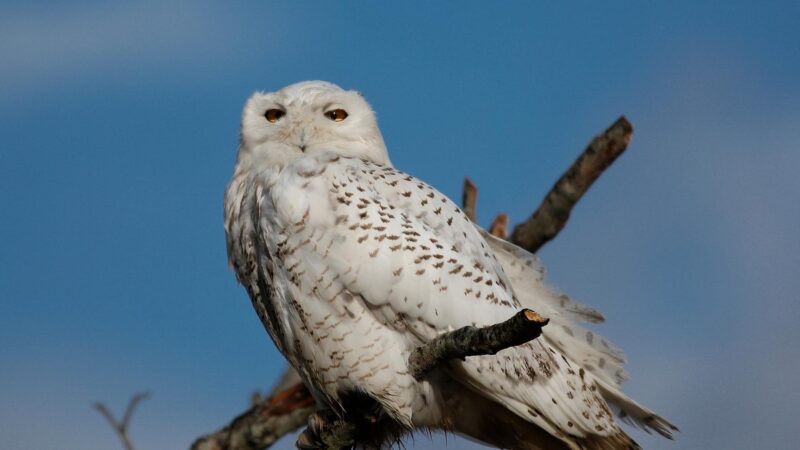
These unmistakably regal predators are specially adapted to cold Arctic climates thanks to their feathers that provide sufficient insulation. Unlike most owl species, they hunt during daylight but are extremely elusive, which impedes research progress conducted by scientists regarding these birds.
- Scientific Name: Bubo scandiacus
- Appearance: Large, bulky-bodied arctic owl with a smoothly rounded head, ear tufts that are rarely visible, and thickly feathered legs and feet.
- Color: Overall white plumage with black or brown markings distributed all over the wings and body. Females generally have more markings that appear peppered on their bodies compared to males. Their eyes are catlike and are yellow in color.
- Lifespan: Up to 9 years (wild), Up to 28 years (captivity)
- Habitat: They generally live in open and treeless areas, such as beach dunes, tundra, salt grass meadows, marshes, and even on airport fields.
- Length: 63 to 73 centimeters
- Weight: 1.45 to 1.6 kilograms
- Wingspan: 126 to 145 centimeters
- Diet: Mostly lemmings, but they also eat other small mammals such as squirrels, rodents, hares, and rabbits. They also feed on birds such as geese, ducks, ptarmigans, and waterfowl.
- Place Of Origin: North America
- Characteristics: Solitary, territorial, migratory, but some are nomadic depending on the abundance of food and diurnal.
Connecticut is home to a variety of raptors, which includes 8 hawk species, 2 eagle species, 3 falcon species, and 9 owl species. They all vary in size and weight, hunting styles, and habitats, but share a common characteristic of being powerful predators that are capable of feeding on other birds and animals.
List of Sources
Good, G. (2008). Buteo lagopus. Animal Diversity Web.
Pajerski, L. (2005). Accipiter gentilis. Animal Diversity Web.
Camfield, A. (2004). Accipiter striatus. Animal Diversity Web.
Dewey, T., Perepelyuk, V. (2011). Accipiter cooperii. Animal Diversity Web.
Kirschbaum, K., Miller, S. (2000). Buteo lineatus. Animal Diversity Web.
